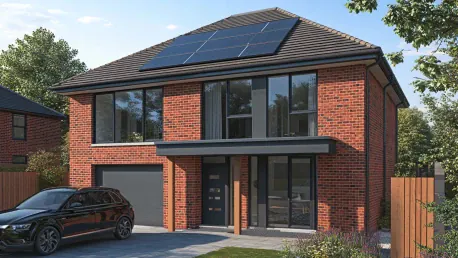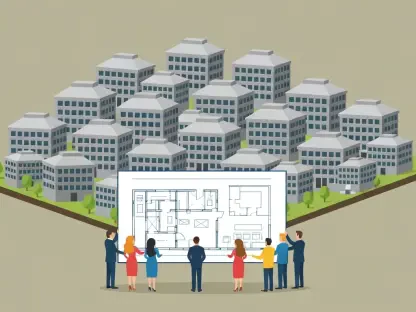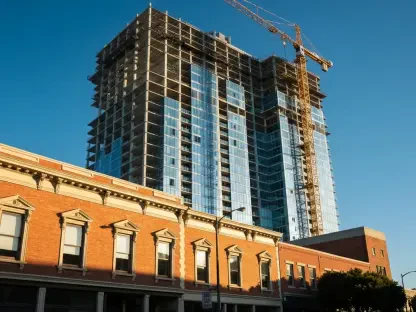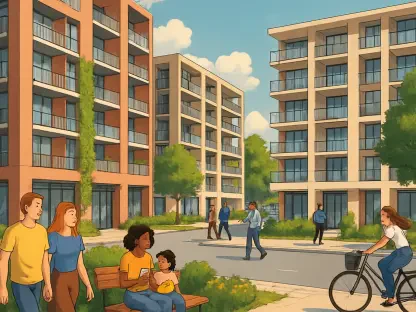As the United Kingdom advances with its ambitious plan to alleviate the housing crisis by constructing 1.5 million new homes, spearheaded by a significant government pledge of £350 million, the conversation surrounding housing quality intensifies. A vital question emerges: can the nation balance the drive for new builds with the imperative need to decarbonize existing housing stock? This challenge not only involves numbers and construction timelines but also intricately ties to energy efficiency, fuel poverty, and the overall wellbeing of the residents. By exploring both aspects, we can aim to achieve a more sustainable and equitable housing future.
The Importance of Retrofitting and Decarbonizing Existing Homes
Enhancing Energy Efficiency to Address Broader Issues
The initiative to upgrade existing homes extends beyond mere structural improvements and steps into a realm where energy efficiency can have a profound impact on daily lives. Derek Horrocks, owner of Sustainable Building Services UK Ltd and chairman of the National Home Decarbonisation Group, underscores the necessity of aligning the vision of new housing with the enhancement of current homes. This alignment translates into the need for thorough retrofitting and decarbonizing efforts which don’t just address energy wastage but also tackle interconnected issues like fuel poverty, and physical and mental health. Furthermore, more energy-efficient homes considerably reduce bills, tangibly alleviating financial stress for numerous families.
Recent developments highlight significant strides, including policies like the Warm Homes: Social Housing Fund and additional allocations from the Autumn Budget. These efforts are specifically aimed at uplifting social housing conditions to meet at least an EPC rating of C. Improved energy standards play a pivotal role in mitigating health hazards such as damp and mold, prevalent in poorly insulated homes. Consequently, these measures result in much more comfortable and healthier living environments, proving that retrofitting current homes is not just an energy-saving move but a step towards improving life quality holistically.
Achieving Equitable Living Conditions Across All Housing
While constructing new homes is undoubtedly crucial to addressing the immediate housing crisis, an overemphasis on new builds could inadvertently create disparities in living conditions, especially between new properties and existing ones. These disparities could widen the gap, leading to inequitable standards of living whereby older homes lag behind in terms of energy efficiency, comfort, and safety. This scenario underpins the need for a balanced approach that values both new construction and the retrofitting and decarbonizing of existing homes.
Ensuring quality, comfortable living conditions for residents of older homes means committing to continuous upgrades that bring these houses up to modern standards. The role of organizations like the National Home Decarbonisation Group becomes paramount in this regard. They advocate for and work towards comprehensive improvements across the UK’s housing stock, which is critical not just for sustainability goals but for ensuring that everyone, regardless of their home’s age, can enjoy safe, healthy living conditions. This dual strategy of new builds and decarbonization harmonizes the overall housing agenda, promoting fairness and wellbeing for all households.
Ensuring Long-Term Commitment and Investment
The Role of Government Initiatives and Funding
A central element of advancing any large-scale housing renovation project is sustained government support, complemented by appropriate financial investment. Various initiatives have been introduced so far, reflecting a shift in recognizing the essential role that existing homes play in the broader housing landscape. Government-backed funds like the Warm Homes: Social Housing Fund represent a critical step towards addressing the energy efficiency of existing homes, ensuring a broader reach and impact. This initiative, coupled with additional funding disbursed during the Autumn Budget, demonstrates a commendable commitment to decarbonizing social housing.
These financial commitments are vital for implementing significant energy-efficient upgrades, such as better insulation, improved heating systems, and installment of renewable energy sources. However, for these initiatives to result in meaningful change, government intervention needs to be consistent and robust. Regular reviews and adjustments in funding allocations can help maintain momentum. Policies also need to be adaptable to address evolving challenges, ensuring that the agenda for retrofitting and decarbonizing homes remains a high priority.
Integrating Policy with Practical Solutions
In tandem with financial investment, the integration of practical solutions that are easily implementable stands as a cornerstone for the success of decarbonizing existing homes. Policy frameworks need to be designed in a way that encourages collaboration between different sectors—construction, technology, and energy production. This integrated approach ensures that the retrofitting process is comprehensive and addresses multiple aspects, from structural redesigns to energy-efficient appliances.
Emphasizing the importance of community engagement within these projects adds another layer of practical consideration. Programs targeting retrofitting and decarbonizing might achieve higher success rates if residents are adequately educated and involved in the process. By empowering homeowners with knowledge and support, the transition towards greener homes becomes a collective effort, fostering a sense of shared responsibility.
Overall, the success of balancing the construction of new homes with the decarbonizing of existing ones will hinge on sustained effort, investment, and community involvement. The future promises a more equitable housing environment if these approaches are effectively combined and continually adapted.
Future Considerations and the Path Forward
Pursuing Dual Strategies for a Balanced Housing Future
The ambitious drive to address the UK’s housing crisis through the construction of 1.5 million new homes needs energetic pursuit without overshadowing the equally important task of upgrading existing homes. Deploying dual strategies ensures that the housing sector evolves holistically, embracing both new builds and the decarbonization of older homes. This combined approach holds the key to promoting energy efficiency, reducing fuel poverty, and enhancing the overall wellbeing of residents. The synergy between new developments and retrofitting can bridge gaps in living standards, leading to a harmoniously built environment.
Continual Innovation and Community Engagement
As the United Kingdom moves forward with its ambitious goal of addressing the housing crisis by building 1.5 million new homes, backed by a substantial government investment of £350 million, the debate around housing quality grows more significant. A critical question arises: can the nation balance the push for new construction with the crucial need to decarbonize existing housing? This challenge isn’t just about numbers and construction deadlines; it also deeply connects to energy efficiency, fuel poverty, and the overall well-being of residents. With these factors in mind, it becomes clear that addressing both new construction and the renovation of current housing stock is essential for achieving a more sustainable and equitable housing future. By carefully considering energy standards and focusing on the welfare of residents, the UK can strive towards a balanced, lasting solution to its housing dilemma.









